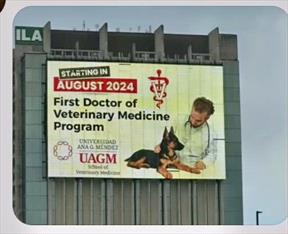Program planned to launch this summer may be among most expensive in the U.S.
 Listen to this story.
Listen to this story.

Photo provided to the VIN News Service
Ana G. Méndez University is advertising its new veterinary program on billboards in Puerto Rico. This one is in San Juan.
Ana G. Méndez University's recent approval by U.S. accreditors to establish Puerto Rico's first veterinary school is drawing a mixed response within the profession. Set to open in August, the program is intended to meet the need for more veterinarians both on the island and worldwide, according to Dr. Shaiana M. Negrón Pagán, dean of the program.
However, with projected tuition likely to make it one of the most expensive schools in the U.S. and no assurances regarding the admission of residents, some wonder how committed the institution really is to Puerto Rico.
In an interview by email with the VIN News Service, Negrón Pagán said none of the 80 or so seats will be specifically earmarked for students who are residents of Puerto Rico. Public universities typically reserve seats for in-state residents at subsidized tuition rates, but AGMU is a private institution. Its veterinary school will consider all candidates in the applicant pool equally, and there are no plans to discount tuition for residents, Negrón Pagán said.
That's disappointing for aspiring veterinarians such as Ana Mayol, a technician from San Juan. "I don't know how I could afford it," she told VIN News.
The four-year school at the university's Gurabo campus, 20 miles south of San Juan, may rank among the priciest veterinary programs in the United States. Tuition and fees for the 2024-25 academic year are expected to be in the range of $75,250 to $79,250, not including health insurance and living expenses. By comparison, some of the most expensive veterinary schools in the U.S. during the current (2023-24) academic year charge first-year tuition and fees of $77,392 (The Ohio State University), $71,845 (Midwestern University in Arizona) and $71,160 to $71,688 (the University of Pennsylvania).
Additional expenses such as housing, food and health insurance can vary widely by location and nearly double the overall cost of attendance.
In reference to tuition for the AGMU program, Negrón Pagán said it aligns with the rates of other U.S. schools. Last month, university President José Méndez Méndez stated similarly to a reporter for the local newspaper El Nuevo Dia. He pointed out that Puerto Rican students already pay nonresident tuition when they attend public U.S. institutions.
Veterinary students from Puerto Rico can access in-state rates if they attend OSU or another public institution that permits students to reclassify as a resident after their first year, which reduces the cost of their education by more than half.
Critics argue that any elevated expense Puerto Ricans face studying off the island does not warrant making it so costly to earn a veterinary degree at AGMU. In reaction to the article in El Nuevo Dia, a reader commented: "This school is totally outside of the economic reality of Puerto Rican students, and I doubt that, with these costs, students from other countries will come. This is out of hand."
About the program
AGMU is the fastest-growing private university system in the nation, according to the institution, with five campuses in Puerto Rico and five in the continental U.S., in addition to multiple smaller satellite campuses. The university is known for offering bilingual education designed to accommodate students who speak Spanish and English. Notably, the veterinary curriculum at AGMU will be exclusively conducted in English.
Plans are in progress to establish both small and large animal teaching hospitals, providing students with opportunities for on-campus clinical training. The program also plans to send fourth-year students to veterinary schools in the continental U.S. for clinical training. The school has established agreements with programs at the University of Florida, Michigan State University, Kansas State University, Purdue University, the University of Missouri and Oregon State University.
Negrón Pagán said she is proud of the plans: "These efforts will ensure our students have the essential exposure to a diversified caseload, which includes both normal and sick animals from both domestic and foreign species servicing as clinical patients or teaching animals."
AGMU, which has an accredited veterinary technology program, has sought to establish a veterinary school since 2017. In 2021, the institution applied for U.S. accreditation, a process that involves multiple steps that span several years. Last spring, a site team with the Council on Education, the accrediting authority of the American Veterinary Medical Association, visited the program. In December, the 20-member COE voted to extend reasonable assurance to the new veterinary school, indicating that evaluators believe it is on track to achieving full accreditation upon the graduation of its inaugural class. The designation enables American students who attend the program to access federal education loans.
The cost of education, often determined by an institution's board of trustees, is not prescribed in the COE's 11 accreditation standards.
Cautious and wary
Some veterinary students from Puerto Rico are eager about the prospect of a new school and disappointed that it's commencing a year or two after they've begun their education elsewhere. Anais De Angel is in her first year at St. George's University School of Veterinary Medicine in Grenada and says she'd rather be studying close to home. "I would have applied!" she said by email. "Especially since Gurabo is very near my hometown of Caguas."
She expressed the expectation that Puerto Rico residents would get a tuition break. Upon learning that's not the case, De Angel said she still would have applied. "For opportunities for either me or my peers, it would be great," she said.
VIN News talked to close to a dozen practitioners and students in Puerto Rico who said they worry about the cost of the program and how it will impact graduates who may enter the workforce burdened with nearly a half-million dollars in student loan debt, including interest. However, their willingness to share their apprehensions is tempered by a reluctance to openly express them, driven by fears of facing blacklisting within the tightly knit and insular veterinary community.
"I can't speak publicly because there are under 1,000 veterinarians practicing in Puerto Rico," said one practitioner. "But they're marketing the heck out of this program, and there are a lot of concerns from the local veterinary community regarding cost, transparency and fairness to the students. It's a private university system that's well known for being very expensive. We are all concerned about how much it's going to cost students. There is absolutely a need for more veterinarians, but some may think this borders on predatory."
VIN News tried to reach the Puerto Rico Board of Examiners of Veterinary Medicine, the licensing authority for veterinarians, for perspective on how the new program might impact the profession, but phone calls were not returned. Similarly, the College of Veterinarians of Puerto Rico, a professional membership organization, has not responded to inquiries from VIN News.